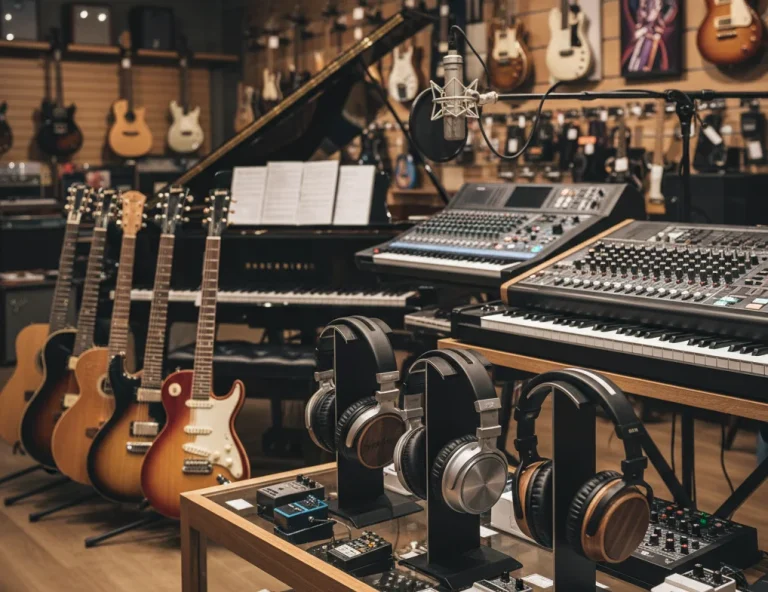All Topics
- Alchemizing Music Concepts for Students
- Artist Spotlight
- artium gift card
- Artium Maestros
- Artium News
- buying guide
- Carnatic Music
- Devotional Music
- Editorials by Ananth Vaidyanathan
- Film Music
- Guitar
- Hindustani Classical Music
- Indian Classical Music
- Indian Folk Music
- Insights
- Instruments
- Karaoke Singing
- Keyboard
- Kids Music
- maestros
- Music Education
- Music for Kids
- Music Industry
- Music Instruments
- Music Legends
- Music Theory
- Music Therapy
- Piano
- piano guide
- Success Stories
- Tamil Film Music
- Telugu Film Music
- Time Theory
- Tools
- Uncategorized
- Vocal Singing
- Vocals
- western classical music
- western music
- Western vocal music
What’s the Guitar Music Theory Behind Notes, Chords & Scales?
What’s the Guitar Music Theory Behind Notes, Chords & Scales?

Table of Contents
The guitar is one of the most popular instruments among music enthusiasts worldwide. If you are reading this, you are an aspiring guitarist or someone who loves the guitar as much as we do.
We have all seen our favorite guitarists transition effortlessly between complex chords, craft mesmerizing solos or instantly figure out a song just by listening to it. Ever wondered how they made it look so easy?
Well, the answer is much more than just talent or endless practice. It is years of practice powered by a deep understanding of guitar music theory. So, whether you are a beginner taking offline or online guitar lessons, a parent of an aspiring guitarist, or a working professional looking to rekindle your passion for music, understanding the guitar and music theory behind notes, chords, and scales will change your relationship with the guitar forever.
In this guide, we will address the guitar theory behind notes, chords and scales, to help you transform your musical journey into something more creative and expressive.
Importance of Understanding Guitar Music Theory
So, let’s get down to addressing the elephant in the room. We may all have come across friends or guitarists who believe in being self-taught or learning basic music theory for the guitar, like memorizing chord shapes and copying licks. While this approach is sufficient for playing a couple of songs at campfires or house parties, it creates a barrier to your musical growth and creativity.
It is like travelling through a new city without preparation, understanding the language or having a map. You may stumble upon some interesting places, but you will never truly explore the city’s hidden gems or understand its layout. That’s precisely what happens when you play without basic guitar theory. You will continue to wander without a roadmap when you could be confidently exploring every corner of your instrument.
Guitar theory for beginners opens up a world of possibilities:
- Creative Freedom – You will learn more about patterns, shapes, how certain combinations work and how to create your own unique sounds.
- Faster Learning – Learning basic music theory for guitars can help you understand the underlying patterns. You will learn new songs easily and recognize familiar chord progressions and scale patterns across different genres.
- Jam with Musicians – Guitar music theory is a language. When your fellow musician says, “Let’s play this in A minor blues progressions,” you will know exactly what they’re talking about.
- Problem-Solving Abilities – Guitar theory provides you with the tools to figure things out. Can’t nail the solo? Theory shows you which guitar modes and scales to use. Want to play a darker riff? Theory is your answer.
- Genre Versatility – Rock, metal, jazz, blues, country or classical; genres are no bar, guitar theory lessons serve as the foundation that connects all musical styles.
This is the reason why, from Eric Clapton to John Mayer to modern guitar virtuosos like Guthrie Govan and Tosin Abasi, all stress the importance of guitar music theory for beginners, combined with cultivating technique and creativity.
What is Guitar Music Theory? Decoding the Basics
In simple terms, guitar theory is nothing but the study of how music works on the guitar. It includes learning the characteristics of the guitar, i.e, the fretboard layout, string tuning, chord voicings and scale patterns.
The following are the elements included in guitar theory –
- The Language of Music – Knowledge of notes, their relation to each other, how intervals create different sounds and emotions and how these elements manifest on the fretboard.
- Structural Elements – Knowledge of chords and scales, their formation and how they are used to create songs, progressions and melodies.
- Practical Applications – Translating theoretical concepts into playable patterns, shapes and techniques that you can use immediately in your playing.
- Pattern Recognition – Developing the ability to recognize and understand visual patterns on the guitar neck, along with the mathematical relations behind them that make music work.
Guitar theory is all about visuals. It’s full of geometric patterns, which, when learned, can be moved up and down the neck to different keys and positions.
The Foundation: Understanding Notes on the Guitar
Before we dive into chords and scales, let us understand the individual notes first. Western music uses twelve notes, i.e A, A♯/B♭, B, C, C♯/D♭, D, D♯/E♭, E, F, F♯/G♭, G, G♯/A♭. When these notes repeat in a cycle, it is known as an octave.
The Standard Guitar Notes
A standard guitar is tuned from lowest to highest, i.e, E-A-D-G-B-E. This is the most common tuning to access 12 notes across 6 strings. Each fret represents one semitone (half-step) of pitch difference, meaning:
- Moving up one fret raises the pitch by one semitone
- Moving up twelve frets brings you to the same note, one octave higher
- The same notes appear in multiple locations across the fretboard.
Finding Notes on Each String
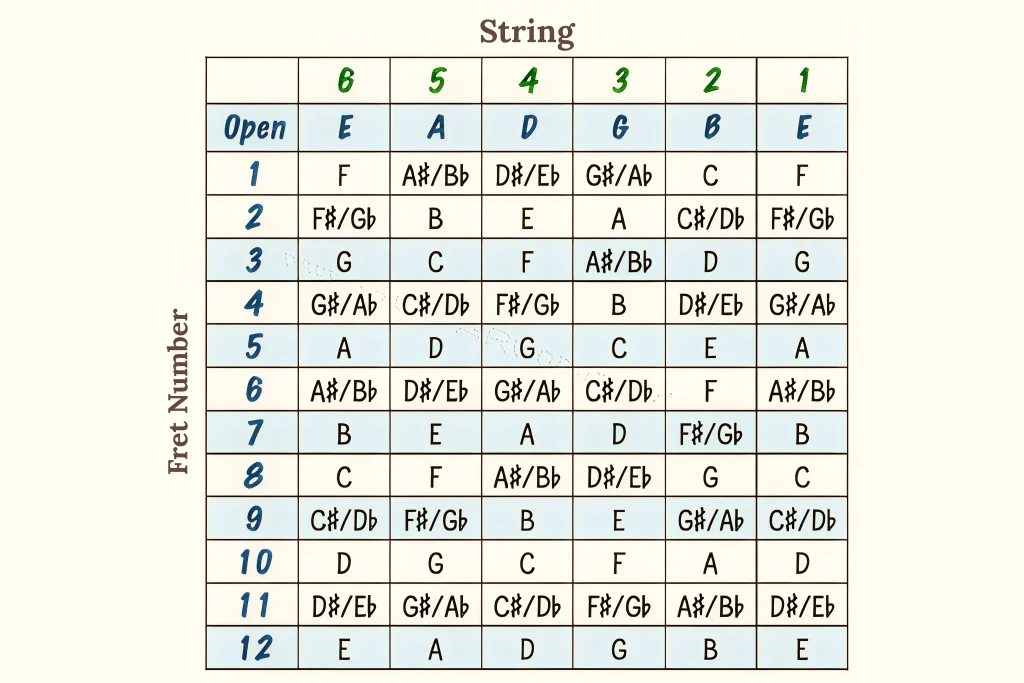
6th String (Low E): E (open) – F (1st fret) – F♯/G♭ (2nd fret) – G (3rd fret) – G♯/A♭ (4th fret) – A (5th fret) – A♯/B♭ (6th fret) – B (7th fret) – C (8th fret) – C♯/D♭ (9th fret) – D (10th fret) – D♯/E♭ (11th fret) – E (12th fret)
5th String (A): A (open) – A♯/B♭ (1st fret) – B (2nd fret) – C (3rd fret) – and so on…
This pattern is identical for all strings; it just continues from a different note. This systematic approach is essential for beginners to understand guitar music theory.
Landmark Notes and Reference Points
Most guitar players memorize key landmark notes on the fretboard to navigate efficiently –
- All notes on the 5th and 7th frets (these correspond to the open string notes)
- All notes on the 12th fret (octaves of the open strings)
- Natural notes (no sharps or flats) across all strings.
These landmarks serve as reference points for quickly locating any note anywhere on the neck.
Understanding The Structure of Guitar Chords
While studying guitar music theory, it is important to understand how chords are constructed. These chords are the harmonic foundation of music. They help create rich, full sounds from the guitar.
1. Basic Chord Construction
All chords are built using intervals, the musical distances between notes. Among these, the most basic chords are triads, which contain 3 notes:
Major Triads: Root+Major Third + Perfect Fifth
- Formula: 1-3-5
- Example: C Major = C-E-G
- Sound: Happy, bright, resolved
Minor Triads: Root + Minor Third + Perfect Fifth
- Formula: 1 – ♭3 – 5
- Example: A Minor = A – C – E
- Sound: Sad, dark, introspective
Diminished Triads: Root + Minor Third + Diminished Fifth
- Formula: 1 – ♭3 – ♭5
- Example: B Diminished = B – D – F
- Sound: Tense, unstable, mysterious
Augmented Triads: Root+Major Third+Augmented Fifth
- Formula: 1 – 3 – #5
- Example: C Augmented = C – E – G#
- Sound: Dreamy, floating, unresolved
2. Extended and Altered Chords
You will encounter more complex chords as your journey progresses in your guitar lessons:
Seventh Chords: Add the seventh interval to triads
- Major 7th: 1 – 3 – 5 – 7 (sophisticated, jazzy)
- Dominant 7th: 1 – 3 – 5 – ♭7 (bluesy, driving)
- Minor 7th: 1 – ♭3 – 5 – ♭7 (smooth, mellow)
Extended Chords: Add 9ths, 11ths & 13ths
- Add9: 1 – 3 – 5 – 9 (open, airy)
- Sus2: 1 – 2 – 5 (floating, unresolved)
- Sus4: 1 – 4 – 5 (tension seeking resolution)
3. Understanding Chord Progressions
In simple terms, chord progressions are a series of chords that create musical movements. What’s most important in progression is understanding the functional harmony of how chords relate to a central key or tonal center.
4. The Major Scale and Roman Numeral Analysis
Take any major key; each scale degree has a corresponding chord function:
I: Tonic (home, stable)
ii: Supertonic (gentle departure from home)
iii: Mediant (mild tension)
IV: Subdominant (departure, anticipation)
V: Dominant (maximum tension, wants to resolve to I)
vi: Submediant (relative minor, melancholy)
vii: Leading tone (strong pull toward I)
5. Common Progressions that Shape Popular Music
I-V-vi-IV: Most popular progression in contemporary music (e.g, C-G-Am-F)
vi-IV-I-V: Minor variations that start in the relative minor (e.g, Am-F-C-G)
ii-V-I: The backbone of jazz harmony (e.g, Dm-G-C)
I-vi-ii-V: Circle progression creating smooth harmonic movement (C-Am-Dm-G)
I-bVII-IV-I: Rock progression adding modal flavor (e.g, C-Bb-F-C)
Understanding these progressions allows you to predict harmonic movement and creates a framework for improvisation and composition.
The Language of Melody: Guitar Scales Explained
Scales are collections of notes required for melodies, solos and harmonic content. To master these essential scales and their connection across the fretboard, it’s recommended that you learn guitar theory.
The Major Scale: Foundation of Western Music
A major scale contains seven notes arranged in whole steps (W) and Half steps (H): W-W-H-W-W-W-H. In the key of C major: C-D-E-F-G-A-B-C
- It’s perfect to study since there are no sharps or flats included
- Each scale degree has a particular functional and characteristic sound
- It forms the basis for understanding all other scales and modes.
The Major Scale Position on Guitar
You can play the major scale within the five interconnected positions across the fretboard:
Start from the lowest root note
Continue the pattern higher up the neck
Find middle positions with comfortable fingerings
Check for higher register positions
Complete the cycle before returning to position 1
Learning these positions as interconnected patterns rather than separate shapes is crucial for fluid fretboard navigation.
The Natural Minor Scale
This scale follows the pattern: W-H-W-W-H-W-W
- Relative relationship: Both scales share the same key signature
- Creates darker and more emotional melodies
- It is the foundation of blues, rock, and other folk traditions.
Pentatonic Scales
This is one of the widely used scales in popular music. It contains 5 notes.
Major Pentatonic: 1-2-3-5-6
- Safe, pleasant-sounding intervals
- Best for country, folk and pop melodies
- Easy to play
Minor Pentatonic: 1–♭3–4–5–♭7
- The base for blues, rock and other popular music
- Works over most chord progressions
- Natural-sounding bends and slides
The Blues Scale
When you add one note to the minor pentatonic, it is a blues scale: 1–♭3–4–♭5–5–♭7
- The addition of ♭5 (blue note) creates characteristic blues tension
- Works well for both major and minor chord progressions
- Essential for rock, blues and jazz improvisation
Connecting Scale Patterns
If you want to master scale use, then it is important to connect patterns seamlessly:
- Horizontal playing: Moving along single strings to create smooth, linear melodies
- Vertical playing: Using multiple strings in small fretboard areas for compact, dense patterns
- Diagonal playing: Combining horizontal and vertical approaches for maximum fluidity
- Position shifting: Smoothly transitioning between scale positions using familiar tones and finger slides
Exploring the Guitar Modes
Guitar modes have the power to add some flavor to your playing. Modes are variations of the major scale—each starts from a different scale degree, creating unique intervallic relationships and characteristic sounds. The Seven Modes include –
1. Ionian (Major Scale): 1-2-3-4-5-6-7
– Character: Bright, happy
– Use: Pop, country, classical
– Feature: Natural major 3rd & 7th
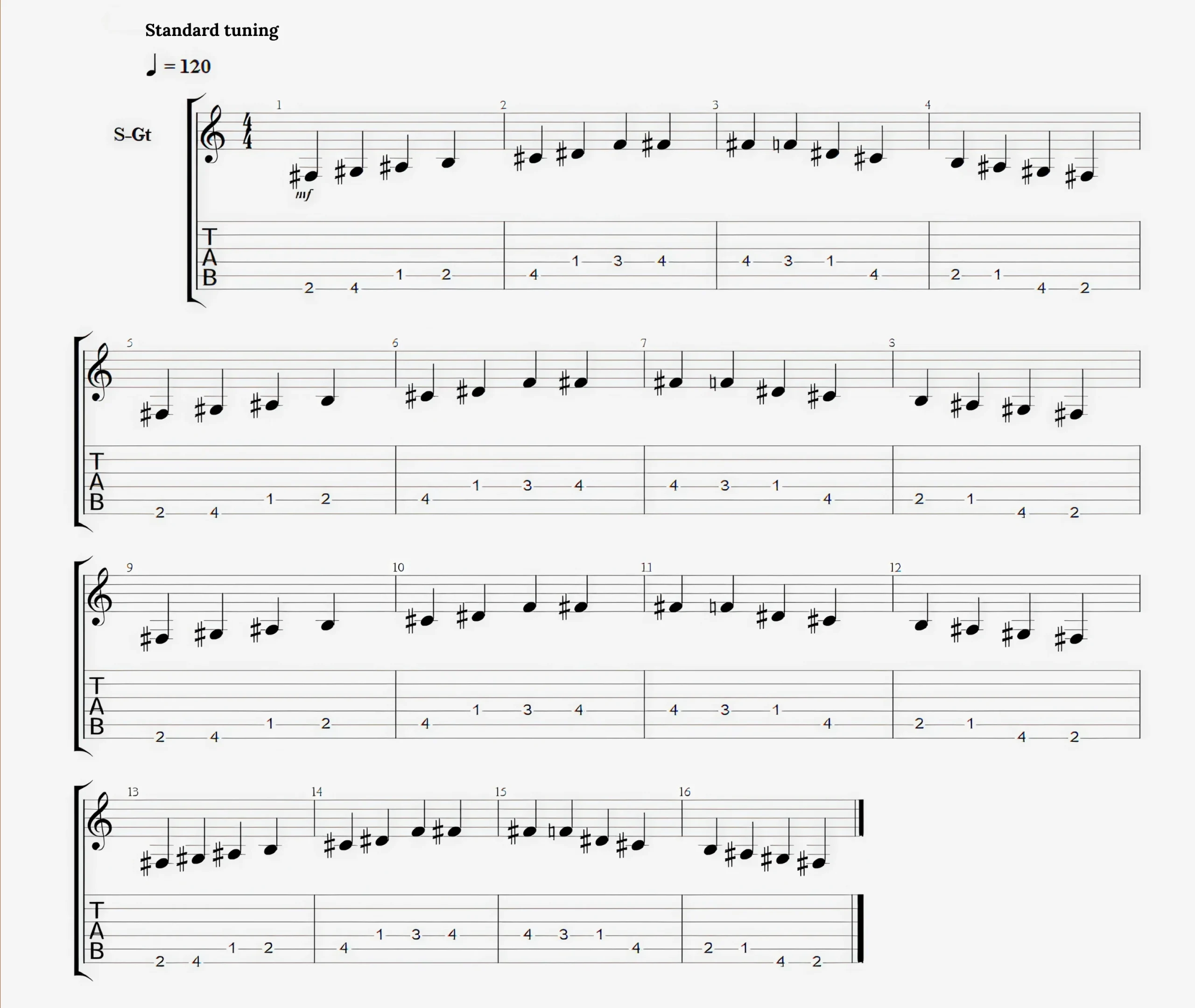
2. Dorian: 1–2–♭3–4–5–6–♭7
– Character: Minor with a hopeful lift
– Use: Jazz, funk, progressive rock
– Feature: Natural 6th in a minor context
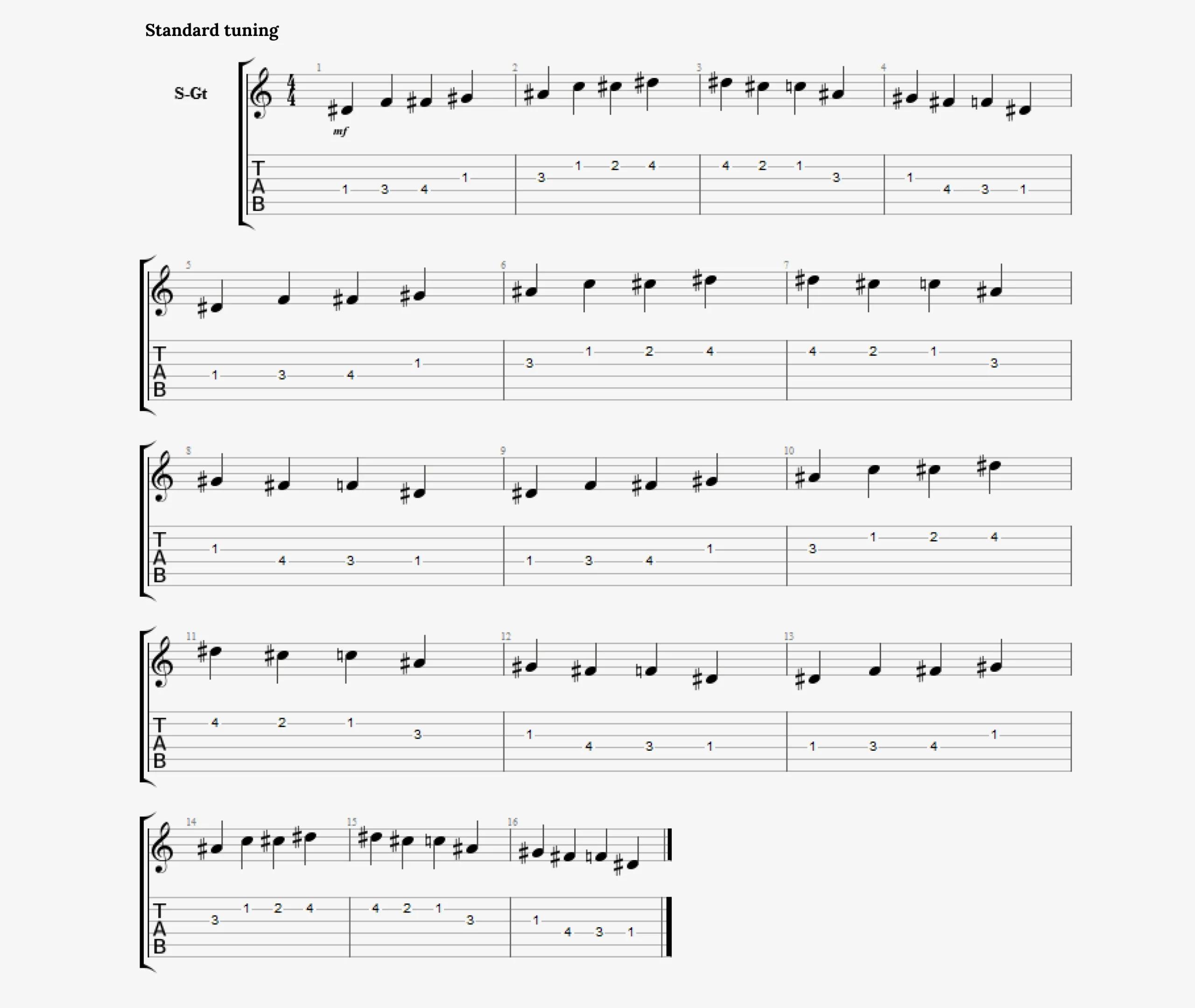
3. Phrygian: 1–♭2–♭3–4–5–♭6–♭7
– Character: Dark, mysterious
– Use: Flamenco, metal, Middle Eastern music
– Feature: Flat 2nd creates exotic flavor
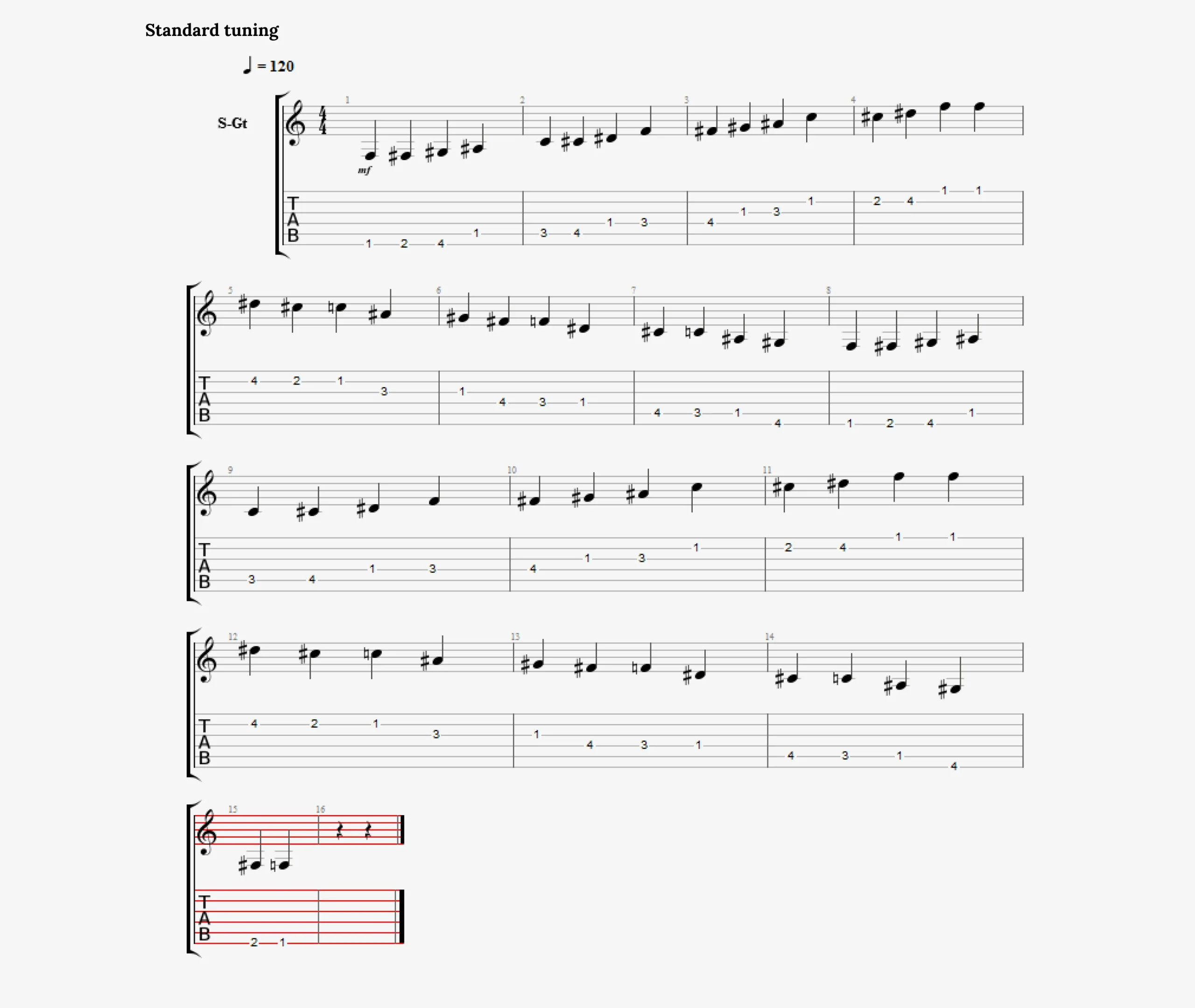
4. Lydian: 1–2–3–♯4–5–6–7
– Character: Dreamy, floating, ethereal
– Use: Film scores, progressive rock, jazz
– Feature: Sharp 4th creates otherworldly sound
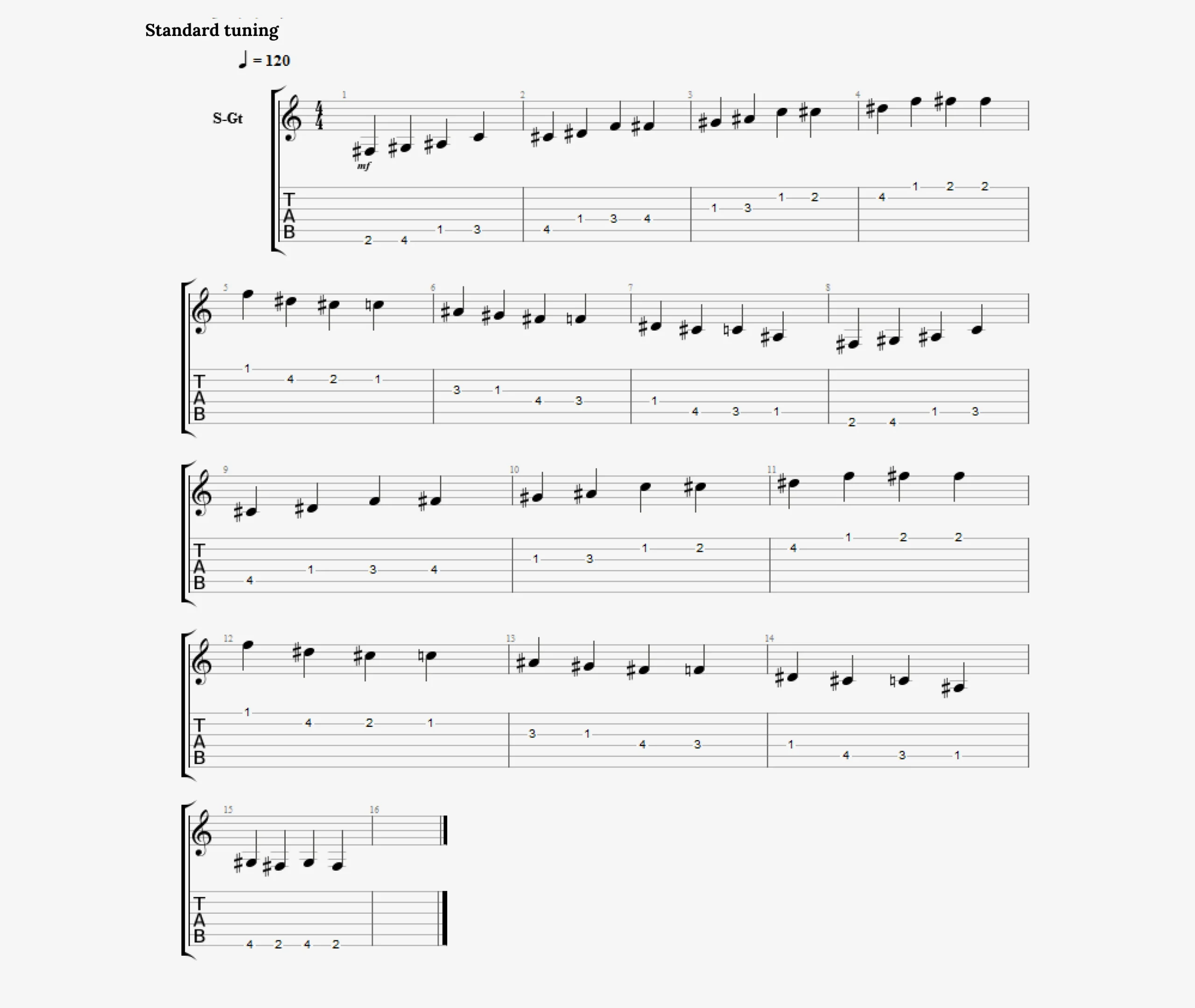
5. Mixolydian: 1–2–3–4–5–6–♭7
– Character: Major but bluesy, driving
– Use: Rock, blues, country, Celtic
– Feature: Flat 7th in major context
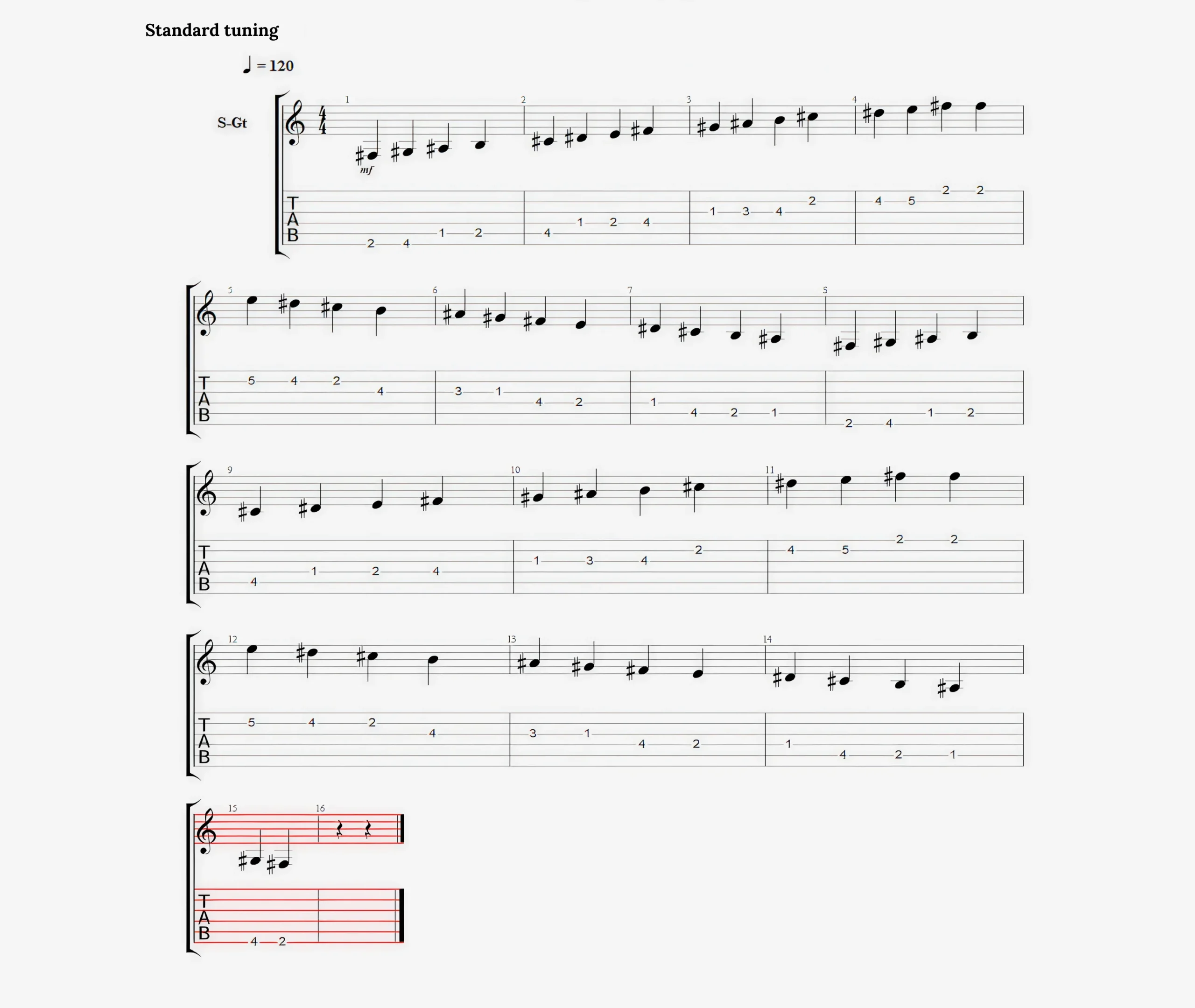
6. Aeolian (Natural Minor): 1–2–♭3–4–5–♭6–♭7
– Character: Sad, introspective, dark
– Use: Ballads, blues, heavy metal
– Feature: Classic minor sound
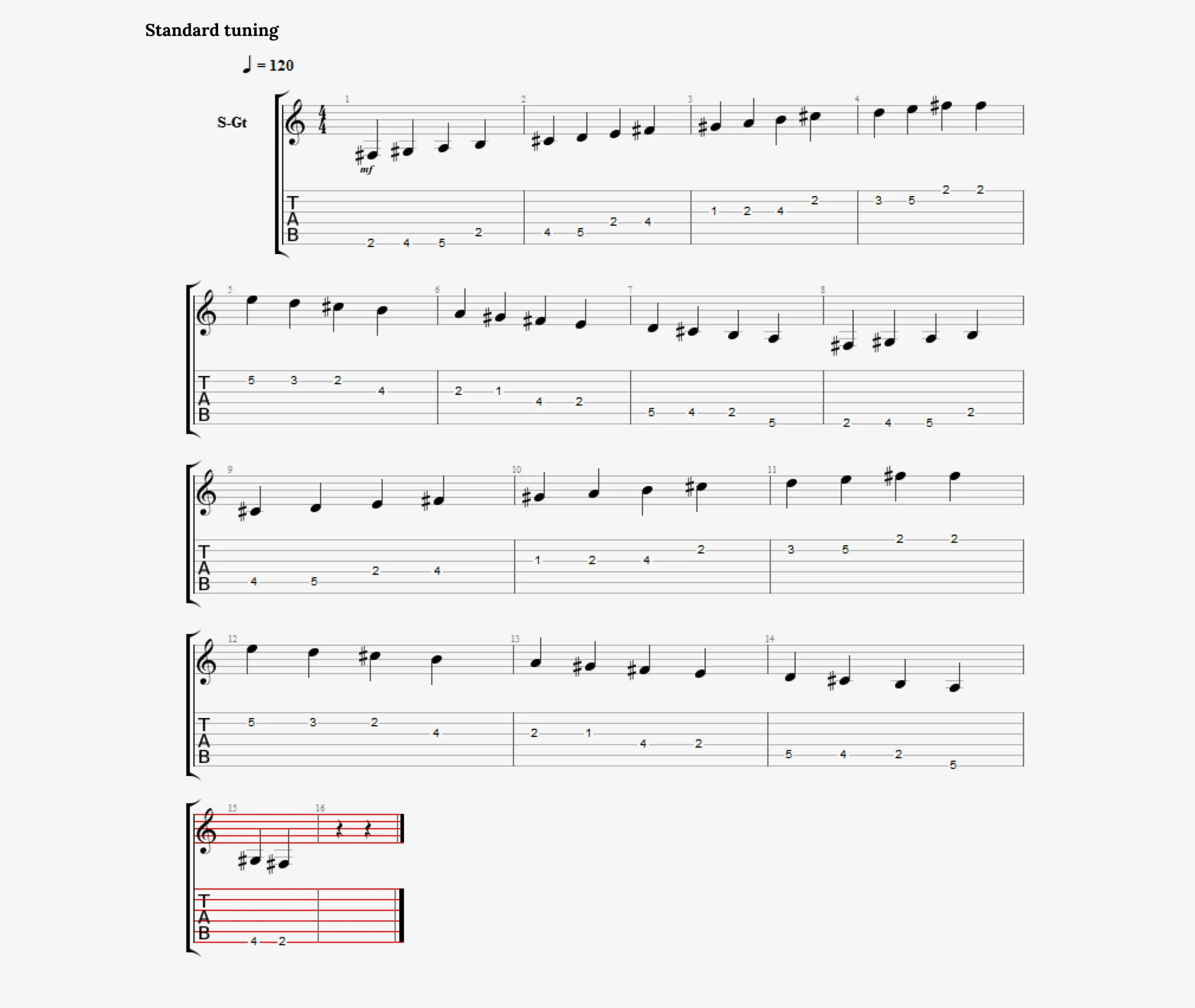
7. Locrian: 1–♭2–♭3–4–♭5–♭6–♭7
– Character: Unstable, tense, theoretical
– Use: Jazz fusion, avant-garde, metal
– Feature: Flat 5th makes it highly dissonant
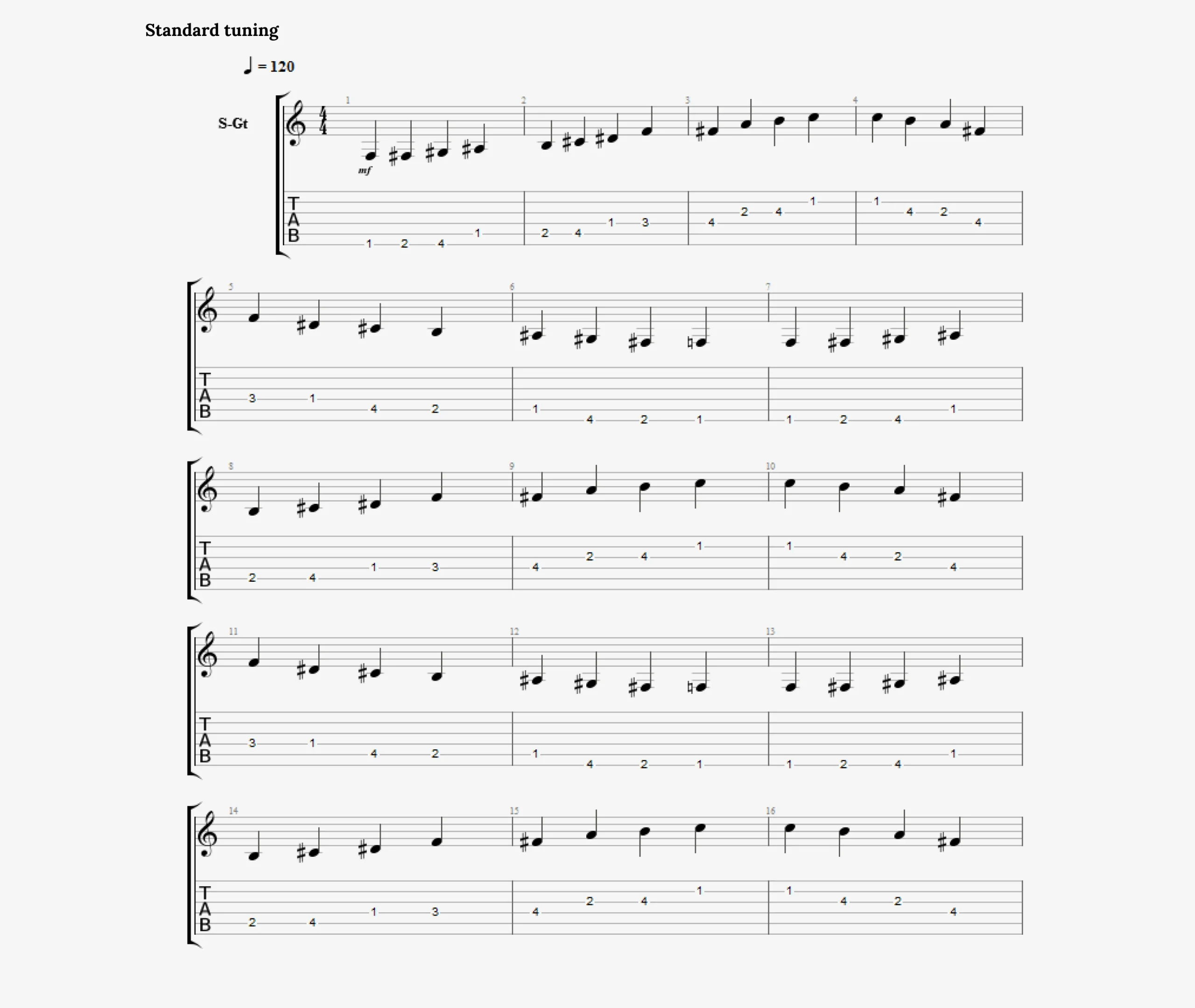
Combining Theory into Practice: Making Music
When you convert your theoretical knowledge into real music, the guitar music theory for beginners you undertook has paid off. Here’s how you can close that gap:
1. Chord-Scale Relationships
To improvise, you have to understand which chords are important:
- Major Chords: Ionian, Lydian or Major Pentatonic
- Minor Chords: Aeolian, Dorian or Minor Pentatonic
- Dominant Chords: Mixolydian, Blues Scale or altered scales
- Diminished Cords: Whole-tone, diminished or chromatic approaches
2. Analyzing Songs Through Theory
Analyze the songs you love:
- Identify the key signature and primary scale
- Track the chord progression by using Roman numerals
- Find the scales and modes used in guitar solos
- Notice the tension and resolution created by the chord change
3. Create Your Own Music
Guitar theory for beginners provides the tools for composition:
- Begin by playing a chord progression in a known key
- Choose the right scales that go well with your chords
- Experience with modal interchange for unexpected colors
- Use voice leading to create smooth chord transitions
4. Practice Strategies for Theory Integration
- Use a cycle of 5ths to play scales and chord progressions through all keys
- Practice scales in different positions while naming the intervals & degrees
- Play chord progressions and improvise melodies using the right scale
- Learn solos by ear, then analyze them theoretically to understand the artist’s choice.
Building Your Musical Foundation
Guitar theory course study becomes most effective when approached systematically:
Phase 1: Foundation Building (Months 1-3)
- Master basic note locations on all strings
- Learn major and minor scale patterns in multiple positions
- Understand basic chord construction and common progressions
- Practice integrating scales with simple chord progressions
Phase 2: Expansion and Application (Months 4-8)
- Add pentatonic and blues scales to your vocabulary
- Explore seventh chords and their applications
- Begin modal studies with Dorian and Mixolydian
- Start analyzing songs you enjoy
Phase 3: Advanced Integration (Months 9+)
- Master all seven modes and their applications
- Understand advanced harmony concepts
- Develop personal voice through theoretical knowledge
- Compose original music using theoretical principles
Transform Your Musical Journey Today
Guitar music theory is crucial for aspiring guitar players, as it distinguishes them from the rest of the song-covering guitarists. Guitar theory provides a roadmap to musical freedom. When you learn guitar theory, you can speak the language of guitar fluently, helping you jam with other musicians.
At Artium Academy, we understand the importance of this and have designed our guitar theory classes to help you reach your musical goals. Our curriculum, curated by renowned Bollywood composer Raju Singh, transforms complex theoretical concepts into practical skills that you can use right away.
With over 30,000 students learning music, we have perfected the art of teaching guitar and helping our students fulfill their dreams worldwide. Our guitar music theory course doesn’t just teach you what to play—it teaches you why it works, how to apply it creatively, and how to develop your own unique musical voice.
Whether you’re seeking guitar lessons near me or prefer the flexibility of online music classes, our platform provides world-class instruction that fits your schedule and learning style. From guitar theory for beginners to advanced harmonic concepts, our structured approach ensures steady progress and lasting understanding.
Ready to unlock the full potential of your guitar playing? Join thousands of students who have transformed their musical abilities through expert guidance and proven curriculum. Book your free trial class today and experience firsthand how understanding guitar and music theory can revolutionize your relationship with music. Your journey from playing notes to making music starts with a single step—and we’re here to guide you every note of the way.
FAQs on Guitar Music Theory
To learn guitar music theory, the most effective approach is to follow a structured method that combines theory and practical application. Start with basics, understand patterns, apply theory to practice, take expert help and practice regularly.
Music theory remains the same for both acoustic and electric guitars. However, its application and expression may differ slightly:
- Electric guitars often use effects and improvisation (modes, extended chords, complex scales).
- Acoustic guitars typically emphasize rhythm, fingerpicking, open chords, and songwriting.
Theoretical knowledge, such as chord formation, scales, progressions, and modes, applies to both, but how you use that knowledge (especially tone, articulation, and genre) varies by guitar type.
Kids can learn guitar theory effectively through:
- Visual learning: Fretboard charts, color-coded notes, and pattern recognition make it a fun and intuitive experience.
- Gamified exercises: Learning scales and chords through games or challenges enhances engagement.
- Simplified concepts: Start with major and minor chords, open positions, and pentatonic scales.
- Structured online classes: Platforms like Artium offer child-friendly courses designed to gradually introduce guitar theory in a fun and practical way, helping kids grasp complex ideas through performance and play.
Our online music classes for kids provides guitar theory and other concepts in detail at Artium Academy.
Yes—but only in application, not in essence.
- Music theory refers to the general framework of understanding how music works (scales, harmony, rhythm, melody).
- Guitar theory is how this general theory is applied specifically to the guitar’s fretboard, patterns, shapes, and tuning.
For example, the concept of a major scale is the same in music theory and guitar theory, but how you visualize and play it on the guitar (positions, fingerings) makes guitar theory unique.
Absolutely. Music theory is foundational for learning the guitar. It helps players:
- Understand how notes, chords, and scales work together
- Recognize progressions across songs and genres
- Improvise solos using the correct scale or mode
- Compose original music
- Collaborate confidently with other musicians
Without theory, players often rely on memorization and struggle with creativity and problem-solving.
The best course offers a blend of structured theory and hands-on application—just like the one offered by Artium Academy. The course:
- It is curated by renowned composer Raju Singh
- Breaks down complex concepts like modes, scales, and harmony
- Emphasizes real-world usage for composition, performance, and improvisation
- Includes 1:1 live instruction, performance reviews, and learning resources







